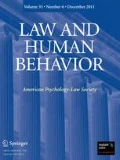Abstract
Since at least the turn of the century, there have been reports indicating that women have an increased tendency toward criminal behavior during certain phases of the menstrual cycle. Recently these reports have served as the basis for a proposal to expand the insanity defense to recognize the impact of menstrual cycles in diminishing criminal responsibility. This paper reviews the empirical literature on the link between menstruation and crime and raises several critical questions regarding interpretation of this data. In light of these questions it is suggested that at this time an insanity defense based on menstrual symptomology would be inappropriate.
Similar content being viewed by others
References
Benson, R. C.Handbook of Obstetrics and Gynecology. Los Angeles: Lange Medical Publications, 1974.
Birtchnell, J., & Floyd, S. Attempted suicide and the menstrual cycle — a negative conclusion.Journal of Psychosomatic Research, 1974,18, 361–369.
Brakel, S. J., & Rock, R. S. (Eds.).The Mentally Disabled and the Law. Revised Edition. Chicago: University of Chicago Press, 1971.
Chiazze, L., Brayer, F. T., Macisco, J. J., Parker, M. P., & Duffy, B. J. The length and variability of the human menstrual cycle.The Journal of the American Medical Association, 1968,204, 6, 377–380.
Cooke, W. R. Presidential address: The differential psychology of the American woman.American Journal of Obstetrics and Gynecology, 1945,49, 457–472.
Cope, E. Dysfunctional bleeding.British Medical Journal, 1971,2, 631–632.
Dalton, K. Menstruation and acute psychiatric illnesses.British Medical Journal, 1959,1, 148–149.
Dalton, K. Effect of menstruation on school girls' weekly work.British Medical Journal, 1960a,1, 326–328.
Dalton, K. Menstruation and accidents.British Medical Journal, 1960b,2, 1425–1426.
Dalton, K. School girls' behavior and menstruation.British Medical Journal, 1960c,2, 1647–1649.
Dalton, K. Menstruation and crime.British Medical Journal, 1961,2, 1752–1753.
Dalton, K. Menstruation and examinations.The Lancet, Dec. 28, 1968, 1386–1388.
Dalton, K.The Premenstrual Syndrome. Springfield, Ill.: C. C. Thomas, 1971.
Ellis, D. P., & Austin, P. Menstruation and aggressive behavior in a correctional center for women.The Journal of Criminal Law, Criminology, and Police Science, 1971,62, 3, 388–395.
Gudden, Die Zurechnungsfahigkeit bei Warenhausdiebstahlen.Vierteljahrsschrift für gerichtliche Medizin und Öffentliches Sanitätswesen. Dritte Folge,33, Suppl., 1907, 66.
Healy, W.The Individual Delinquent. Boston: Little, Brown, 1915, 632–633.
Heard, S.La Femme Pendant la Periode Menstruelle. Paris: Felix Alcan, 1890, 136.
Kaiser, I. H. Synchronizers of reproductive function in men and women. In M. Ferin, F. Halber, R. L. Richart, & R. L. Vande Wiele (Eds.),Biorhythms and Human Reproduction. New York: Wiley, 1974.
Kopell, B. S., Lunde, D. T., Clayton, R. B., & Moos, R. H. Variations in some measures of arousal during the menstrual cycle.Journal of Nervous and Mental Disease, 1969,148, 180–187.
Lombroso, C., & Ferrero, G.Das Weib als Verbrecherin and Prostituierte. trans. by H. Kurella. Hamburg: Verlagsanstalt and Druckerei, A.G., 1894, 364.
Mackinnon, P. C. B., & Mackinnon, I. L. Hazards of the menstrual cycle.British Medical Journal, 1956,1, 555.
Mandell, A. J., & Mandell, M. P. Suicide and the menstrual cycle.Journal of the American Medical Association, 1967,200, 132–133.
Matsumoto, S., Igarashi, M., & Nagaoka, N. Environmental anovulatory cycles.International Journal of Fertility, 1968,13, 15–23.
Matsumoto, S., Nogami, Y., & Ohkuri, S. Statistical studies on menstruation: A criticism on the definition of normal menstruation.The Gunma Journal of Medical Sciences, 1962,11, 294–318.
Matsumoto, S., Thoma, K., Kubo, H., Watanabe, M., Hosaka, H., & Utsuno, A. Environmental menstrual disorders.The Gunma Journal of Medical Sciences, 1965,14, 1–15.
McClintock, M. K. Menstrual synchrony and suppression.Nature, 1971,229, 244–245.
Morton, J. H., Additon, H., Addison, R. G., Hunt, J. J. A clinical study of premenstrual tension.American Journal of Obstetrics and Gynecology, 1953,65, 1182–1191.
O'Connor, J. F., Shelley, E. M., & Stern, L. O. Behavioral rhythms related to the menstrual cycle. In M. Ferin, F. Halberg,R. M. Richart,& R. L. Vande Wiele (Eds.),Biorhythms and Human Reproduction. New York: Wiley, 1974.
Oleck, H. L. Legal aspects of premenstrural [sic] tension.International Record of Medicine and G. P. Clinics, 1953,162, 492–501.
Paige, K. E. Effects of oral contraceptives on affective fluctuations associated with the menstrual cycle.Psychosomatic Medicine, 1971,33, 515–537.
Paige, K. E. Women learn to sing the menstrual blues.Psychology Today, 1973,7, 41–47.
Parlee, M. The premenstrual syndrome.Psychological Bulletin, 1973,80, 454–465.
Ruble, D. N. Premenstrual symptoms: A reinterpretation.Science, 1977,197, 291–292.
Shainess, N. A re-evaluation of some aspects of feminity through a study of menstruation: A preliminary report.Comparative Psychiatry, 1961,2, 20–26.
Simon, R. J. The contemporary woman and crime.Crime and Delinquency Issues. Washington, D.C.: National Institute of Mental Health, 1975.
Smith, A. J. Menstruation and industrial efficiency. I. Absenteeism and activity level.Journal of Applied Psychology, 1950a,34, 1–5.
Smith, A. J. Menstruation and industrial efficiency. II. Quality and quantity of production.Journal of Applied Psychology, 1950b,34, 148–152.
Sutherland, H., & Stewart, I. A. critical analysis of the premenstrual syndrome.The Lancet, June 5, 1965, 1180–1183.
Wallach, A., & Rubin, L. The premenstrual syndrome and criminal responsibility.UCLA Law Review, 1971,19, 209–312.
Wickham, M. The effect of the menstrual cycle on test performance.British Journal of Psychology, 1958,49, 34–41.
Zeisel, H., & Diamond, S. S. “Convincing empirical evidence” on the six member jury.The University of Chicago Law Review, 1974,41, 281–295.
Author information
Authors and Affiliations
About this article
Cite this article
Horney, J. Menstrual cycles and criminal responsibility. Law Hum Behav 2, 25–36 (1978). https://doi.org/10.1007/BF01047499
Issue Date:
DOI: https://doi.org/10.1007/BF01047499



